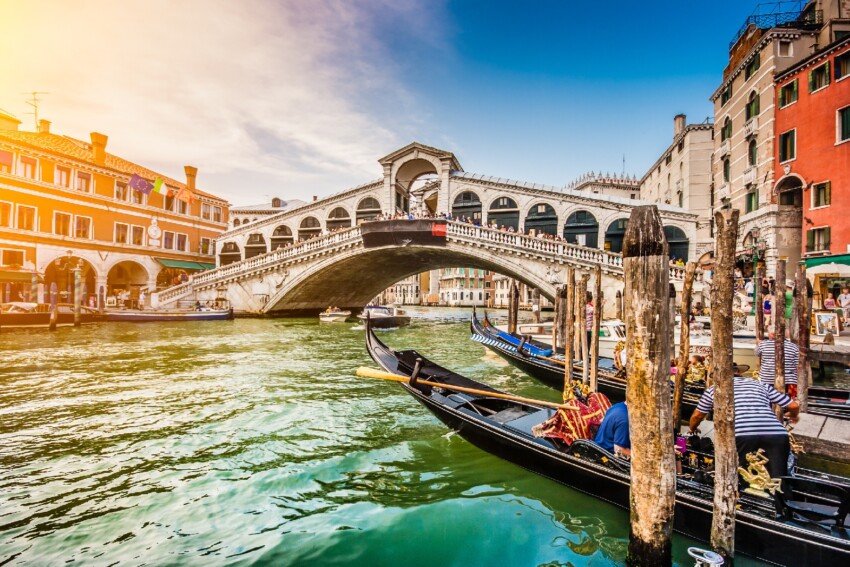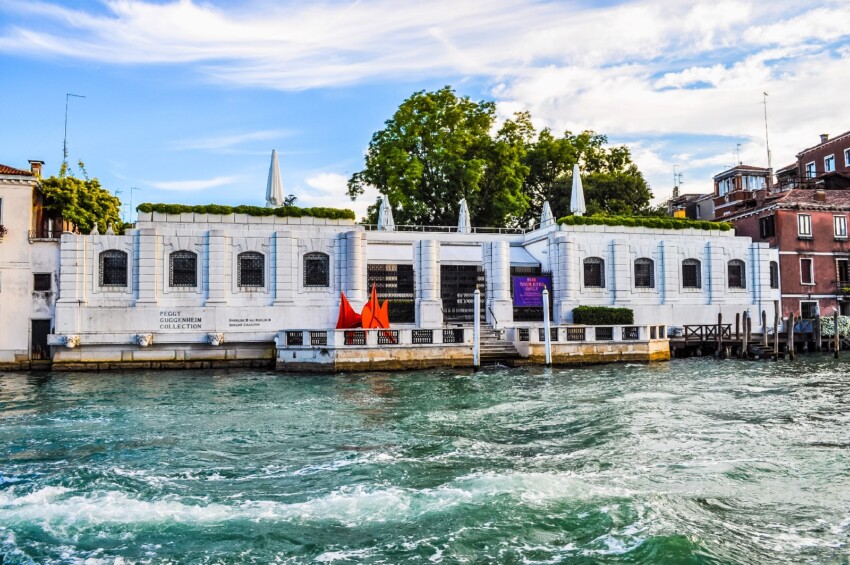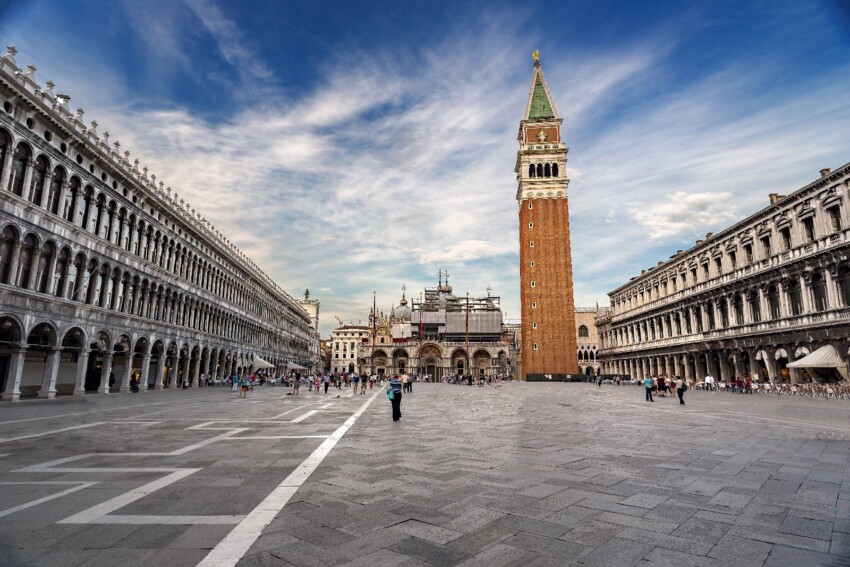

It is ironic that in a city rich in history and art, the main tourist attraction is not a museum or monument: what everyone wants to see in Venice is the Grand Canal, the waterway that bisects the historic city centre.
Despite its name, it is not the largest canal in Venice: the Giudecca Canal is slightly longer and more than twice as wide. It is, however, without a shadow of a doubt, the most famous: almost 4 km long, with its characteristic snake or S-shape, the Grand Canal (or Canalasso, as Venetians call it) is a synthesis of tourist clichés and real Venetian life.
Along its banks are some of Venice’s most visited attractions, including its most famous bridge and some of its most beautiful museums. For Venetians, however, the Canalasso is above all the city’s main thoroughfare, and is often an obligatory passage to get from one part of the city to another.
It is not possible to follow the route of the Canalasso on foot: for a large part, in fact, it is not lined with pedestrian streets but with palaces directly on its banks. These are the typical Venetian palaces once inhabited by doges, nobles, writers, musicians, politicians, and high-ranking clergymen.
Today almost all these stately homes have become luxury hotels or museums open to the public: for a night or an hour you too can relive the splendour of the golden age of the Serenessima, among rooms sumptuously decorated with brocades, silks, Murano chandeliers and other marvels.
You can move along the Grand Canal by zigzagging between the banks on foot and the calli on the inside; an easier and more enjoyable way, however, is to travel the entire length by vaporetto or, even better, by gondola.
Our list of things to see on the Grand Canal is a symbolic itinerary that takes you from Piazzale Roma, the arrival point for cars and buses, to St Mark’s Square.

The bridge where our Grand Canal itinerary begins is the most modern of the four bridges connecting the two banks of the canal. It is the Ponte della Costituzione, better known as the Calatrava Bridge after the famous international architect who designed it.
Inaugurated in 2008, this modern steel and glass construction has attracted a great deal of criticism due to its very high cost and structural problems, which have made maintenance work necessary from the outset; in addition, many feel that the bridge’s appearance is completely out of harmony with the surrounding buildings.
These criticisms had the only effect of increasing the bridge’s fame and making it a noteworthy attraction.

The second bridge over the Grand Canal that one encounters agrees with everyone: although it is fairly recent (it was inaugurated in 1934), it echoes traditional Venetian bridges in its aesthetics and materials. It is a wide arched bridge in Istrian stone with 80 steps, built to replace an earlier cast-iron bridge considered unsafe.
Its official name is Ponte degli Scalzi (named after the nearby church), but more often you will hear it called Ponte della Ferrovia (Railway Bridge) because it is located a short distance from the train station.

The third attraction is the first in a long series of elegant palaces overlooking the Grand Canal that you can admire: their halls, rich in history, are now prestigious venues for cultural institutions, museums, important administrative offices, luxury hotels; their richly ornamented facades on which gates with direct access to the canal open are an exceptional photographic subject.
The first in the series is Palazzo Ca’ Vendramin Calergi, a Renaissance patrician-style building constructed in the 16th century. For centuries it was the stately home of doges, duchesses, counts and musicians (in fact, it was the last Venetian residence of the famous composer Richard Wagner); since the 1950s it has housed one of the two headquarters of the Venice Casino.

A splendid white façade, richly ornamented in Venetian Baroque style, conceals two of Venice’s most beautiful museums: the 17th-century palace of Ca’ Pesaro is home to the Gallery of Modern Art and the MaOV (Museo Orientale di Venezia).
The latter is famous for its collection of Japanese art from the Edo period, considered one of the most important in the world; it also exhibits Burmese lacquerware, Thai silverware and porcelain, textiles and Indonesian puppets used in the shadow theatre.
A duchess was the last owner of Ca’ Pesaro, and it was her wish to make it a treasure chest of artistic treasures open to visitors.

Splendid in its current appearance, the Ca d’Oro with its original façade finished in gold (hence the name) must have been a spectacular sight… dazzling, probably. It is considered one of the finest examples of Venetian flamboyant Gothic.
It is currently home to the Giorgio Franchetti Gallery, which exhibits a collection of bronzes, sculptures, Venetian and Flemish paintings.

The right address for classy shopping in Venice is Fondaco dei Tedeschi (or Fontego dei Tedeschi), a luxury shopping centre housed inside a historic palace facing the Rialto Bridge.
It’s an address to mark down even if you can’t afford to shop in expensive boutiques: on the top floor of the palace is a magnificent rooftop terrace from which you can enjoy a splendid view of the Grand Canal.
Only opened in 2016, the terrace at Fondaco dei Tedeschi is already one of the most visited attractions in Venice; admission is free but must be booked online on the mall’s official website.

The third bridge along the Grand Canal needs no introduction: the magnificent Rialto Bridge is one of Venice’s top attractions and one of the city’s symbols.
It is the oldest of the four bridges on the Grand Canal (it was built in the 16th century), the only one that is covered and has shops that are still functioning today; it has an archway over 28 metres long and reaches a maximum height of 7.5 metres.
You may have already seen it countless times on postcards, tourist guides, TV or the Internet, but seeing it in person is a unique emotion. Take the time to admire it from below before climbing the steps that lead you to the other side; stop at the top for a look down and the customary photo with the Grand Canal as a backdrop.
Another sumptuous residence of nobles and intellectuals now used as an exhibition venue is Mocenigo Palace; the museum housed in its elegant rooms is dedicated to the history of textiles and costume; a special section, to be visited with eyes and nostrils open, is dedicated to perfume.
The palace still retains many of its original furnishings, splendid examples of 18th-century Venetian furniture.

Don’t be fooled by its less rich façade compared to other palaces you have already seen along the Grand Canal: Grassi Palace also has a long and noble history.
It was the last great palace overlooking the canal to be built before the fall of the Serenissima; the restoration of the interior by Japanese architect Tadao Ando in the 20th century has added a further reason to be interested in architecture.
Palazzo Grassi currently hosts temporary exhibitions mainly dedicated to contemporary art.

Prepare for a full immersion in 18th-century Venice with a visit to Ca’ Rezzonico, a magnificent palace built by a very rich Venetian family in the 17th century but completed by another, even richer family in 1750.
Its sumptuous rooms faithfully reproduce those of a typical aristocratic residence of the time and are the most suitable venue for the 18th-century Museum. On display are paintings, frescoes, furniture and objects of everyday life.

Here we come to the last bridge of our itinerary on the Grand Canal, the Accademia Bridge: in chronological order, however, it is the second one, built after Rialto, a little before the Railway Bridge and almost a century before the Constitution Bridge.
Made of wood, it deviates considerably from the typical image of the Venetian white stone bridge. It was meant to be a temporary bridge, to be used pending the construction of a more solid stone bridge; the latter was never built and the Accademia Bridge still joins the banks of the Grand Canal at San Vidal and the former Church of Santa Maria della Carità.

A palace that immediately catches the eye during a gondola or vaporetto ride is Palazzo Venier dei Leoni, lower and longer than the other historic buildings overlooking the Grand Canal.
This 18th-century building with its neoclassical façade, unusual in form but typically Venetian in splendour, is the Venetian headquarters of the world-famous Peggy Guggenheim Collection, one of the most important cultural institutions dedicated to 20th-century art in the world.

The Basilica of Santa Maria della Salute is one of the best known images of Venice. This magnificent octagonal church at the mouth of the Grand Canal, where the canal flows into St. Mark’s Basin, appears in numerous photos and postcards. It was built in the second half of the 17th century to celebrate the end of the plague and is considered a masterpiece of Venetian Baroque.
The Baroque exuberance of its façade and its gigantic domes certainly do not go unnoticed: you will have no difficulty recognising it.
On the Feast of Our Lady of Health, 21 November each year, the basilica can be reached by a temporary wooden bridge.

We are almost at the end of the itinerary and it is a grand finale indeed. Built in the late 15th century, the splendid palace of Ca’ Giustinian is one of the finest examples of late Venetian Gothic. Its red brick and white stone façade, characterised by elegant symmetries of triple lancet windows and balustrades, is a true marvel and the interior is no less sumptuous.
Currently Ca’ Giustinian houses the administrative offices of the Venice Biennale, exhibition spaces, meeting rooms, an archive of contemporary art and a workshop for workshops and educational projects.

The Grand Canal ends in St. Mark’s Basin, the stretch of water in front of one of the most famous and visited squares in the world.
St. Mark’s Square and its extraordinary attractions (first and foremost the Basilica, but also the Campanile, the Moors of Venice, the Caffè Florian, the Correr Museum) almost always represent the arrival point of a one-day itinerary in Venice, but you can also consider them a starting point for exploring the Arsenale area or other areas less known to tourists.
One thing is certain: you have to pass through here sooner or later, because San Marco is one of the places to see at least once in a lifetime.
In the following map you can see the location of the main places of interest mentioned in this article.
Boasting an enviable location, convenient to all tourist attractions and full of charm, hotels overlooking the Grand Canal are the most popular in Venice.
Many of the historic palazzi overlooking the canal have been converted into boutique hotels, b&b’s or luxury holiday flats, but despite the large number of establishments on both banks if you want to be sure of sleeping in a Grand Canal view room we recommend booking well in advance.
Prices are generally not cheap, both because of the high demand from tourists and because many facilities are high-end, with a few 3-star hotels and many 4- or 5-star ones.
However, if your holiday budget is tight, don’t despair: it is still possible to find some family-run hotels with affordable rates. To spend a little less you can forgo the rooms with a view or sleep in quieter areas, moving away from the crucial points of mass tourism (the station, the Rialto bridge, the arrival at San Marco).
The best hotels on the Grand Canal have double entrances so you can get there either on foot or by gondola or water taxi. A private balcony is rather unusual because Venetian palaces generally do not have large open spaces outside; however, some hotels have a small terrace on the Grand Canal where guests can sip a drink or relax while watching the boats go by.
The Grand Canal runs through the entire centre of Venice: as soon as you leave the train station you will already find it in front of you.
If you arrive in Venice by car you will have to leave your car in Piazzale Roma, and from there once you cross the Ponte della Costituzione you will already be on the Grand Canal.
The Grand Canal bisects the centre of Venice, from Santa Lucia Station to St. Mark's Square.
City Card allow you to save on public transport and / or on the entrances to the main tourist attractions.
